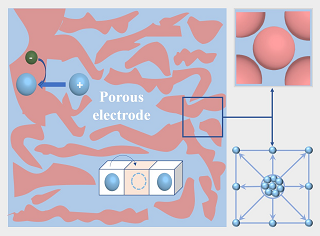

锂离子电池多孔电极理论的回顾与新思考
收稿日期: 2020-07-14
修回日期: 2020-09-10
网络出版日期: 2020-09-23
基金资助
国家自然科学基金项目(21832004);国家自然科学基金项目(21773175);国家自然科学基金项目(21673163)
Porous-Electrode Theory of Lithium Ion Battery: Old Paradigm and New Challenge
Received date: 2020-07-14
Revised date: 2020-09-10
Online published: 2020-09-23
王晓晓 , 周子睿 , 单强 , 张增明 , 黄俊 , 刘欲文 , 陈胜利 . 锂离子电池多孔电极理论的回顾与新思考[J]. 电化学, 2020 , 26(5) : 596 -606 . DOI: 10.13208/j.electrochem.200651
A critical review on the porous electrode theory developed by Newman and his colleagues is presented. We propose several ideas for further development of this theory by analyzing its limitations. The classical Newman theory does not consider ion steric effect in describing ion transport in electrolyte solutions, which can be amended by a newly developed ion-vacancy coupled charge transfer model for ion transport in concentrated solutions. Ion transport in solid particles of active materials is essentially an ion-electron coupled transport process, and its rationality is verified by comparing the calculated and experimental diffusion coefficients of Li + ion in intercalation materials. The methods for describing multiscale structures of porous electrodes and the theories of porous structure reconstruction are summarized, and their applications in determining the effective transport parameters are presented and discussed.
We would like to point out that further development remains necessary for porous electrode theory, especially with the emerging of new materials and systems to meet high energy and power density. A number of issues associated with/raised by high working current densities should be considered, for instances, nonlinear non-equilibrium mass transportation, overlapping of electrical double layer (EDL) and mass transport layer, the interfacial charge transfer kinetics, the fusion of phase and interface, the phase transformation of electrode materials in the process of charging and discharging, and the coupling among electrochemical, thermal and mechanical properties and processes.
It is our consensus to build a universal theoretical framework that can contain electrochemistry, thermodynamics and mechanics in the electrochemical systems, with careful consideration of microscopic mechanisms for charge and mass transfer in different spatial and temporal domains.

/
| 〈 |
|
〉 |